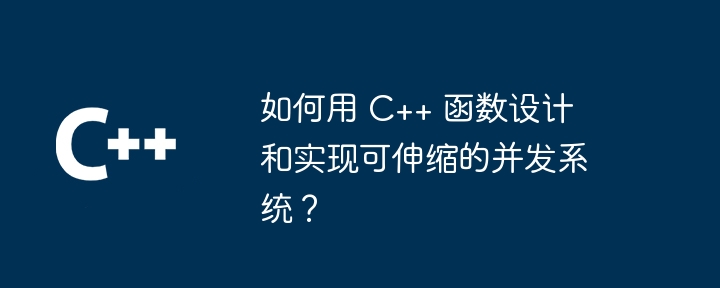Home >Backend Development >C++ >How to design and implement scalable concurrent systems using C++ functions?
How to design and implement scalable concurrent systems using C++ functions?
- 王林Original
- 2024-04-27 11:57:02437browse
By following the principles of atomicity, thread safety, and reusability, and utilizing mechanisms such as threads, locks, and atomic variables, C provides the powerful features needed to create scalable concurrent systems, such as parallel summation and other practical cases. shown.

Using C functions to build scalable concurrent systems
Introduction
In modern software development , concurrency is critical to handle heavy computations and improve application responsiveness. C provides powerful parallel and concurrent programming features that enable developers to design highly scalable concurrent systems.
Designing C concurrent functions
When designing effective C concurrent functions, you need to consider the following key principles:
- Atomicity:The state changed by the function should remain consistent and indivisible among all threads.
- Thread safety: The function should be thread-safe, which means that it can be executed concurrently in multiple threads without data races or deadlocks.
- Reusability: Functions should be designed to be modular and reusable to promote code reuse and maintainability.
Implementing C concurrent functions
C provides a variety of mechanisms to achieve concurrency, including threads, locks and atomic variables:
-
Threads: Each thread has its own independent execution flow. Threads can be created and managed using the
std::threadlibrary. -
Lock: Lock is used to coordinate access to shared resources. Mutexes can be created and locked using the
std::mutexlibrary. - Atomic variables: Atomic variables are variables that are not thread-safe, but can perform atomic operations such as reading, writing, and modifying.
Practical case: Parallel summation
The following is an example of how to use C concurrent functions to write a parallel summation program:
#include <vector>
#include <thread>
#include <mutex>
#include <atomic>
std::mutex sum_mutex;
std::atomic_int total_sum;
void sum_partial(const std::vector<int>& numbers, size_t start, size_t end) {
int partial_sum = 0;
for (size_t i = start; i < end; ++i) {
partial_sum += numbers[i];
}
// 使用锁保护共享变量
std::lock_guard<std::mutex> lock(sum_mutex);
total_sum += partial_sum;
}
int main() {
std::vector<int> numbers = {1, 2, 3, 4, 5, 6, 7, 8, 9, 10};
const size_t num_threads = 4;
std::vector<std::thread> threads;
// 分割向量并创建线程执行并行求和
const size_t chunk_size = numbers.size() / num_threads;
for (size_t i = 0; i < num_threads; ++i) {
size_t start = i * chunk_size;
size_t end = (i + 1) * chunk_size;
threads.emplace_back(sum_partial, std::ref(numbers), start, end);
}
// 等待所有线程完成
for (auto& thread : threads) {
thread.join();
}
// 打印总和
std::cout << "Total sum: " << total_sum << std::endl;
return 0;
}Conclusion
By following the correct principles and taking advantage of the concurrency tools provided by C, developers can create highly scalable and thread-safe concurrency systems.
The above is the detailed content of How to design and implement scalable concurrent systems using C++ functions?. For more information, please follow other related articles on the PHP Chinese website!

